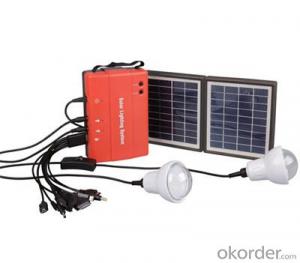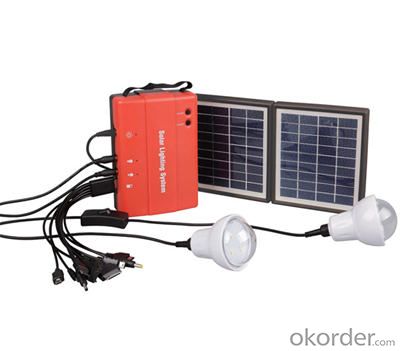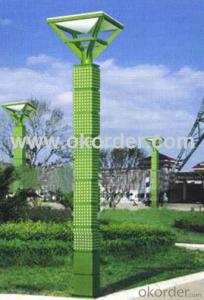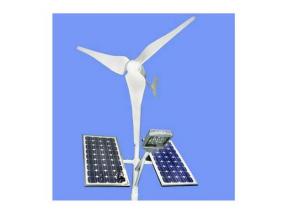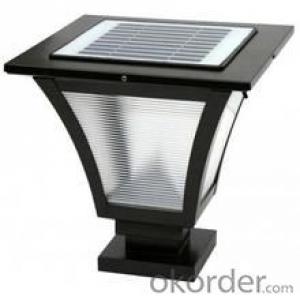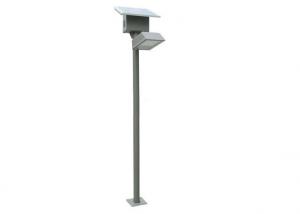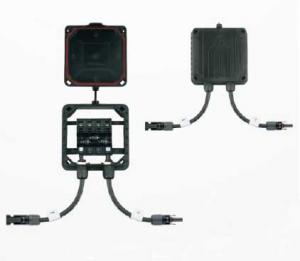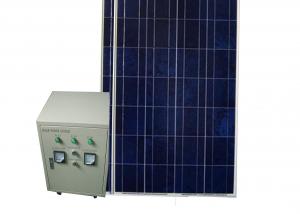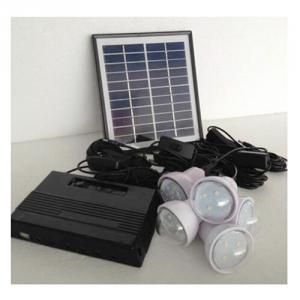MINI SOLAR LIGHTING SYSTEM
- Loading Port:
- Guangzhou
- Payment Terms:
- TT OR LC
- Min Order Qty:
- -
- Supply Capability:
- 10000 unit/month
OKorder Service Pledge
Quality Product, Order Online Tracking, Timely Delivery
OKorder Financial Service
Credit Rating, Credit Services, Credit Purchasing
You Might Also Like
Description:
Portable Solar Lighting System With 2 Lights
1, Foldable solar panels
3, USB mobile charging
Rechargeable by 3.4W solar panel
Body Material: ABS+PC
Battery: 4.5AH/6V Lead acid
Lighting time: 15 hours working after fully charged for 2 bulbs
Overcharge, over dischargeprotection controller
Accessory: 2 pcs of 0.9W LED bulbs with 5M long line cord each
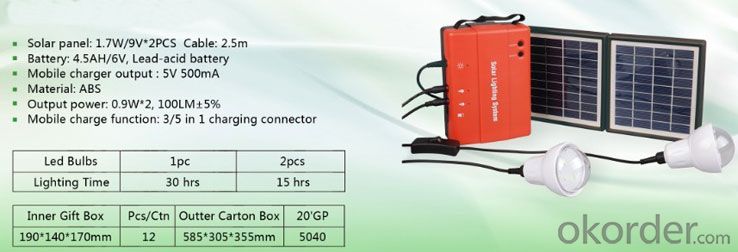
- Q: Can solar energy systems be used in powering car charging stations?
- Car charging stations can definitely be powered by solar energy systems. Actually, many car charging stations worldwide already rely on solar energy. Solar panels can be placed on the roof or in close proximity to the charging station, capturing sunlight and converting it into electricity. This renewable energy can then be used to charge electric vehicles (EVs) without depending on the traditional power grid. Solar-powered car charging stations have several advantages. Firstly, they provide a sustainable and clean energy source, reducing carbon emissions and the overall environmental impact of EVs. Secondly, they can be installed in remote or off-grid areas where connecting to the electrical grid may be difficult or costly. This makes solar-powered charging stations especially beneficial for rural regions or highways lacking easy access to electricity. Additionally, solar energy systems can incorporate battery storage, enabling excess energy generated during the day to be stored and utilized during the night or periods of high demand. This guarantees a continuous and reliable power source for car charging stations, even in the absence of sunlight. Although the initial installation cost of solar energy systems may be higher when compared to traditional power sources, their long-term operating and maintenance costs are generally lower. Moreover, there are various government incentives and rebates available to promote the use of renewable energy, which can help offset these initial expenses. All in all, solar energy systems offer a viable and sustainable solution for powering car charging stations, providing environmental benefits, energy independence, and long-term cost savings.
- Q: How do solar energy systems affect the reliability of the electrical grid?
- Solar energy systems can have both positive and negative effects on the reliability of the electrical grid. On the positive side, solar energy systems can help diversify the energy sources used for electricity generation, reducing dependence on traditional fossil fuels. This diversification can enhance the overall stability and reliability of the electrical grid. Furthermore, solar energy systems can contribute to reducing peak demand on the grid. During daylight hours, when solar panels are most productive, they generate electricity that can be directly utilized by nearby buildings or fed back into the grid. This can help alleviate stress on the grid during periods of high demand, reducing the likelihood of power outages or blackouts. However, solar energy systems also present some challenges to grid reliability. One of the key concerns is the intermittent nature of solar power generation. Solar panels only produce electricity when the sun is shining, meaning that their output is subject to variations due to weather conditions and the time of day. This intermittency can make it challenging to match supply with demand, especially during cloudy or nighttime hours, leading to potential imbalances or fluctuations in the grid. To address this issue, grid operators need to carefully manage the integration of solar energy systems into the electrical grid. This involves implementing advanced forecasting and monitoring technologies to accurately predict solar power generation and plan for any potential fluctuations. Additionally, energy storage systems, such as batteries, can be deployed to store excess solar energy during periods of high generation and release it during times of low generation, helping to smooth out the intermittent nature of solar power. Overall, while solar energy systems bring many benefits to the electrical grid, such as diversification of energy sources and reducing peak demand, they also pose challenges related to intermittency. By adopting advanced technologies and implementing effective grid management strategies, these challenges can be mitigated, ensuring a reliable and resilient electrical grid.
- Q: How long does it take to recoup the investment in a solar energy system?
- The length of time it takes to recoup the investment in a solar energy system varies and depends on several factors such as the initial cost of the system, the amount of energy it generates, the cost of electricity in the area, and any available incentives or tax credits. On average, it can take anywhere from 5 to 15 years to recoup the investment in a solar energy system. However, with the decreasing cost of solar panels and the potential long-term savings on electricity bills, the payback period is becoming shorter, making solar energy a more attractive and economically viable option for many homeowners and businesses.
- Q: What is the warranty period for solar energy systems?
- The warranty period for solar energy systems typically varies depending on the manufacturer, but it is commonly between 10 to 25 years.
- Q: Can solar energy systems be used for powering electric vehicle taxi services?
- Certainly, electric vehicle taxi services can certainly harness the power of solar energy systems. Solar energy, a renewable and sustainable power source, can be harnessed through the installation of solar panels. These panels convert sunlight into electricity, which in turn can charge the batteries of electric vehicles utilized for taxi services. By utilizing solar energy systems, taxi operators can significantly decrease their dependency on conventional electricity grids and fossil fuels. This not only aids in reducing greenhouse gas emissions but also cuts down on the expenses associated with running electric vehicle taxi services. Solar energy systems can be set up on the rooftops of taxi service stations or on the premises of charging stations. Any surplus energy generated during the day can be stored in batteries for later use during the night or on cloudy days when sunlight is scarce. Furthermore, solar energy can be employed to power the necessary infrastructure for electric vehicle taxi services. This encompasses charging stations, dispatch systems, and other operational equipment. Through incorporating solar power into these systems, taxi service providers can further enhance sustainability and reduce their carbon footprint. However, it is crucial to carefully plan the size of the solar energy system to meet the energy demands of the electric vehicle taxi fleet. Factors such as the number of vehicles, distance traveled, and the availability of sunlight should be taken into consideration when determining the appropriate size of the solar energy system. In conclusion, solar energy systems are indeed a viable option for powering electric vehicle taxi services. They offer a sustainable and cost-effective solution that reduces reliance on conventional energy sources and aids in mitigating climate change.
- Q: What is the role of solar energy systems in promoting social equity?
- Solar energy systems play a crucial role in promoting social equity by providing access to clean and affordable energy for all. These systems reduce the reliance on fossil fuels, which disproportionately affect low-income communities. By enabling households to generate their own renewable energy, solar power helps reduce energy costs and creates opportunities for economic empowerment. Additionally, solar energy projects can be implemented in marginalized communities, creating local job opportunities and fostering community development. Overall, solar energy systems contribute to a more equitable society by addressing energy poverty and reducing environmental injustices.
- Q: What are the benefits of using solar energy?
- There are several benefits of using solar energy. Firstly, it is a renewable and sustainable source of energy, meaning it does not deplete natural resources. Secondly, solar energy helps reduce greenhouse gas emissions, contributing to a cleaner and healthier environment. Additionally, using solar energy can lead to significant cost savings on electricity bills, as it reduces dependence on traditional utility companies. Furthermore, solar panels require minimal maintenance and have a long lifespan, making it a reliable and durable energy solution. Lastly, solar energy promotes energy independence, as it allows individuals and communities to generate their own power, reducing reliance on external sources.
- Q: Do solar energy systems require a lot of wiring?
- Solar energy systems necessitate a specific amount of wiring, which is contingent on the size and intricacy of the system. Generally, wiring is indeed necessary in solar energy systems to link the solar panels to the inverter and subsequently to the building's electrical panel. This wiring is crucial in transmitting the electricity generated by the solar panels to the appliances and electrical loads in the building. The quantity of wiring required is also influenced by the placement of the solar panels and the distance between the panels and the building's electrical panel. If the panels are installed on the roof, additional wiring might be essential to connect the panels to the inverter, typically positioned inside the building. Conversely, if the solar panels are ground-mounted near the building, the wiring distance may be shorter, resulting in a reduced amount of wiring needed. Furthermore, the complexity of the system can also impact the wiring requirements. For instance, if the system incorporates battery storage or if it is a grid-tied system with net metering, extra wiring might be necessary to connect the batteries or the utility meter. In summary, although some wiring is necessary in solar energy systems, the quantity can fluctuate based on factors such as system size, location, and complexity. It is always advisable to consult with a professional solar installer to evaluate your specific requirements and ascertain the appropriate amount of wiring needed for your solar energy system.
- Q: Are there any environmental impacts associated with solar energy systems?
- Yes, solar energy systems have some environmental impacts, but they are significantly lower compared to traditional fossil fuel sources. The production and disposal of solar panels can generate some waste and emissions, but these are relatively minimal compared to the ongoing pollution caused by burning fossil fuels. Additionally, land use for large-scale solar installations can impact local ecosystems. However, proper planning and implementation can minimize these impacts, and the long-term benefits of solar energy in reducing greenhouse gas emissions and mitigating climate change far outweigh any potential negative environmental effects.
- Q: Can solar energy systems be installed in areas with heavy snowfall?
- Yes, solar energy systems can be installed in areas with heavy snowfall. However, it is important to consider the impact of snow on the system's performance and take necessary precautions during installation. Snow can temporarily reduce the amount of sunlight reaching the solar panels, which in turn reduces their energy production. However, the panels are designed to have a tilt and smooth surface, allowing snow to slide off easily. Additionally, advancements in technology have led to the development of snow-resistant solar panels that are more effective at converting sunlight into electricity even in snowy conditions. It is also worth noting that solar panels are often mounted at an angle to maximize their exposure to the sun, which helps to minimize snow accumulation. Overall, while heavy snowfall may impact the efficiency of solar energy systems, they can still be successfully installed and can contribute to renewable energy generation in areas with such climatic conditions.
Send your message to us
MINI SOLAR LIGHTING SYSTEM
- Loading Port:
- Guangzhou
- Payment Terms:
- TT OR LC
- Min Order Qty:
- -
- Supply Capability:
- 10000 unit/month
OKorder Service Pledge
Quality Product, Order Online Tracking, Timely Delivery
OKorder Financial Service
Credit Rating, Credit Services, Credit Purchasing
Similar products
Hot products
Hot Searches
Related keywords
